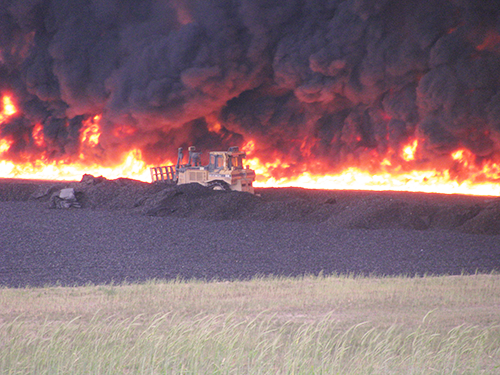
| April 2015 | |||||||||||
| Top stories | |||||||||||
| In the news | |||||||||||
| Photos | |||||||||||
| Contact us | |||||||||||
| Archive | |||||||||||
|
Journal publishes study about landfill fire |
On May 26, 2012, a fire began at the Iowa City Landfill and spread across a drainage layer made from an estimated 1.3 million shredded tires. The landfill liner burned for 18 days, producing a black cloud that could be seen from miles away.

A landfill staffer bulldozes the grounds of the landfill to fight the fires on the night of Saturday, May 26. (Photo by Rick Fosse, courtesy of the City of Iowa City)
As the fired smoldered, staff from the Hygienic Laboratory conducted field-based testing for contaminants at the emergency site and in surrounding locations. The story of their work is told in, “Uncontrolled combustion of shredded tires in a landfill-Parts 1&2,” two peer-reviewed articles published in Atmospheric Environment, Volume 104, March 2015.
Shredded tire chips are permeable to leachate and are commonly used as landfill drainage lining material, providing a way to dispose of scrap tires while also protecting the landfill’s liner. This sometimes has environmental consequences. Tire fires may burn for more than a month while emitting potential contaminants into the air and in run-off water.
Despite the possible hazards of using tire scraps as landfill lining, there is little documentation of the public health response to these environmental emergencies.
Did you know?
- In the U.S. in 2011, the Rubber Manufacturers Association estimated the generation of 231 million scrap tires.
- Tires are a useful chemical commodity, construction material and solid fuel, due to their high energy density.
- The largest tire fire in U.S. history began in 1983 in Winchester, Virginia. Seven million tires burned in nine months, polluting air and water in three surrounding states.
To fill this void, a team of individuals, including members of the State Hygienic Lab, carried out this two-part study. Don Simmons, environmental lab manager, and Brian Wels, environmental lab scientist, contributed to part one of the study led by Betsy Stone, UI assistant professor in Chemistry and Jared Downard, UI graduate student in chemistry. Environmental Health Division Director Michael Wichman, and Matthew Mainprize, environmental lab analyst, contributed to part two of the study that was led by Charles Stanier, UI associate professor in Chemical and Biochemical Engineering, Ashish Singh, UI graduate student in Chemical and Biochemical Engineering, and Scott Spak, UI Public Policy Center.
Part one of the study describes how “continuous monitoring and laboratory measurements were used to characterize the gaseous and particulate emissions and to provide new insights into the qualitative nature of the smoke and the quantity of pollutants emitted.” Prior to this study, the open burning of tires had only been studied in small-scale, laboratory experiments. The field samples taken from surrounding locations in this study, however, reflect the real-world implications of uncontrolled tire burning.
Downard and the other authors discovered that “[fine particulate mass] from tire combustion was shown to contain azaarenes (PAH with nitrogen heteroatoms, a toxic substance often associated with coal tar production) and picene, a compound previously suggested to be unique to coal-burning.” The authors also identified discrepancies between their study and previous studies in controlled environments, noting that “despite prior laboratory studies' findings, metals used in manufacturing tires (i.e. Zinc, Lead, Iron) were not detected in coarse particulate matter at a distance of 4.2 km downwind.”
Part two of the study “quantifies the impact of the fire on local air quality and proposes a monitoring approach and an air quality index (AQI) for use in future tire fires and other urban fires.” Hazard ratios were used to rank individual pollutants from fires based on acute and cancer-relative risks. Sulfur dioxide, particulate matter, and aldehydes had the highest acute hazard ratios.
The authors “estimate that smoke concentrations reached unhealthy outdoor levels for sensitive groups out to distances of 3.1 km and 18 km at 24-[hour] and 1-[hour] average times, respectively.” Using this information, the article provides recommendations for responding to large-scale urban fires.
The article’s unprecedented monitoring of an uncontrolled large-scale tire fire discovered valuable information that could not be found in controlled laboratory environments. Areas affected by future fires now have a comprehensive guide for an effective public health response.
Part one of the article and part two are available online.